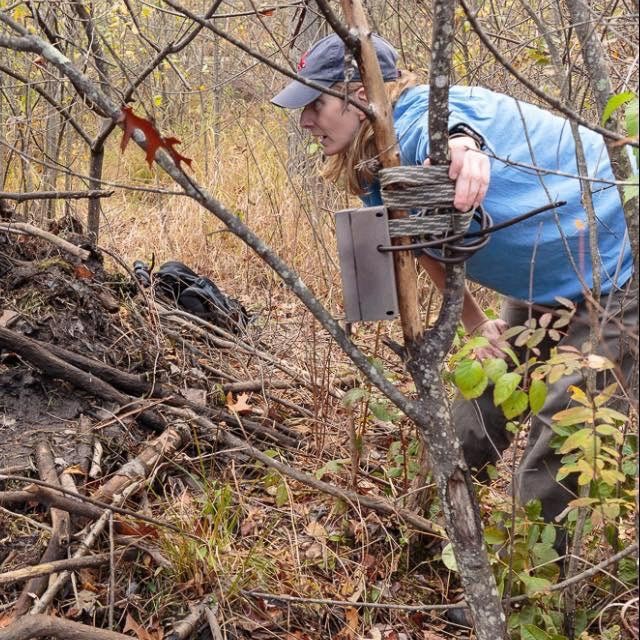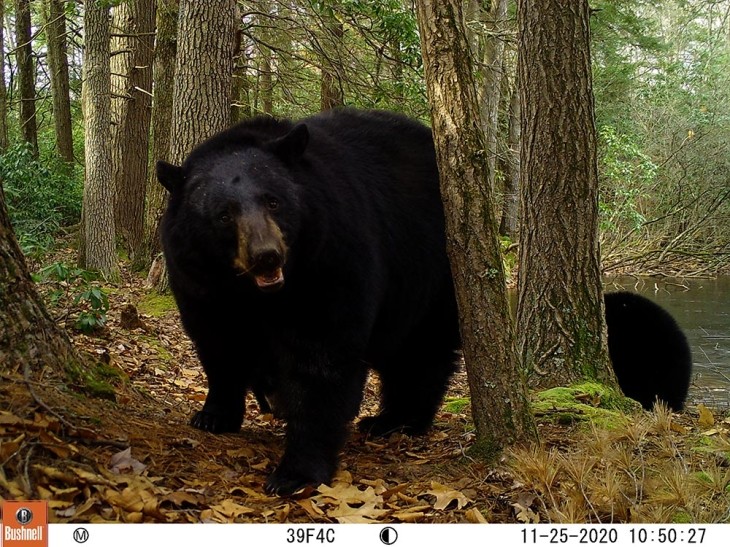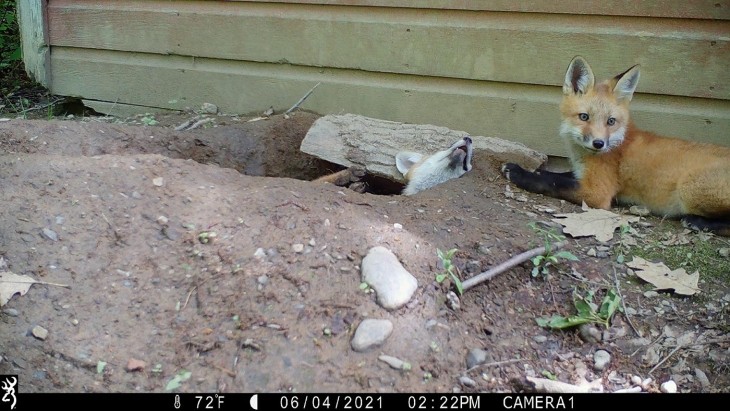
Sally Naser is the director of conservation restriction (a.k.a. easement) stewardship for The Trustees of Reservations, in Massachusetts. She’s also worked for the Appalachian Trail Conservancy and is a skilled camera trapper who has snagged photos and videos of a wide array of wildlife, which she shares on her website and through social media channels. She consults with other camera trappers to help them capture a glimpse of, as she says, “what goes bump in the night.” She also collaborates with private landowners and conservation organizations, using images captured with trail cameras to identify wildlife on their land and make informed management decisions.
I was born in western Pennsylvania, near Pittsburg, but spent a good bit of time in western Maryland as well. My grandmother had a little cottage in Garrett County, which is about the farthest west you can go in Maryland. It has weather like New Hampshire and Vermont, and the woods that I grew up with are very similar to the woods where I work now. I came here to Massachusetts in 1997 to go to grad school at the Conway School of Landscape Design. It was the first place I had ever lived that felt like home. Everything was the same – the woods, the trees, the wildlife. The only wildlife that we didn’t have in western Maryland that we have here is moose.
I grew up on a 5-acre farm. My parents ran a flower shop and a nursery. My father was a self-taught horticulturist, and my mother was an artist and avid naturalist. Although we lived only 20-25 minutes from downtown Pittsburgh, we were very much in the woods and surrounded by wildlife. Our land bordered the northern, forested portion of a 130-acre Boy Scouts of America property. I’m very much my mother’s child. What she enjoyed as a kid was instilled on me – going to ponds with your net and catching salamanders and tadpoles. I’ve always been drawn to ponds and wetlands.
The school district I went to was very ahead of its time and had an environmental education program. We had a teacher named Beulah Frye who drove an “ecology bus” around to all of the elementary schools. She had plasters of a bobcat print and fossils and a taxidermied squirrel and pressed plants. At 54 years old, I still remember my very first field trip with her in first grade. She took us to a big pond next to our school where we looked for painted turtles sunning on logs and scooped up tadpoles and red spotted newts in our nets to study in our buckets and then release. Her love of nature was infectious, and she believed the best way to protect the earth was by teaching her students hands-on how to connect with it.
I’ve never been a person who can work in an office all day. I went to work for the Appalachian Trail Conservancy (ATC) as the boundary program manager in 2005. While I was there, the Smithsonian Institute did a trail camera study between southwest Virgnia and Maryland to look at the impact of human activity on wildlife. In this area, the Appalachian Trail is buffered by a narrow corridor – on average about 1,000 feet wide – of National Park Service lands acquired to protect the footpath where it wasn’t already on state or federally owned land. As an ATC employee, I could log into the site where the volunteer camera deployers uploaded their photos. I remember the first night my colleague in Harper’s Ferry gave me the password to log in. It was already well past quitting time, and I don’t think I went home until 2 o’clock in the morning. I just kept going through folder after folder. It was fascinating. There were photos of bear, bobcat, coyote, fox, raccoon, fisher, and of course lots of deer. And with that, the wildlife camera seed was planted.
Barred owl hunting in a vernal pool in the hilltowns of western MA.
My favorite place in the woods to camera trap is an upland vernal pool in western Massachusetts. For eight and a half years, I’ve had at least two to three cameras deployed there year-round. It’s an amazing place through every season. Despite the droughts we’ve had, even if it’s just a slimy green puddle, a bear cub will still come to get a drink there. Without wildlife cameras, I never would have known barred owls and hawks hunt in vernal pools, go into the water, get their feathers wet, and grab unsuspecting frogs, salamanders, and even an occasional crayfish in their talons.
I started with the Trustees of Reservations in 2010 and I am now the director of conservation restriction stewardship. We’re the only state out of all 50 states to call it a restriction versus an easement. A conservation restriction is a wonderful tool to protect the conservation values of the land while still retaining ownership. The Trustees is the oldest land trust in the country, founded in 1891. We protect over 20,000 acres in perpetuity with conservations restrictions, primarily on privately owned land. These properties can be anything from woodland and wetland habitats to meadows, working farms, and recreational open space.
One of the most important parts of my team’s job is the relationships we build with the landowners. In terms of our stewardship obligation, we only visit properties once a year. In my third year with the Trustees, we received a grant to buy four wildlife cameras, and this has given me the opportunity to visit some properties six or seven times a year to check the cameras, and to really get to know those landowners. All of the landowners were just amazed at what we were seeing. It was so rewarding to watch an 80-year-old landowner who had lived there for 50 years see a picture of a bobcat on their land for the first time. It’s such a tangible thing. I could talk for hours about the importance of protecting land, but with a 10-second video of a mother bear and her cubs, it all becomes crystal clear why conservation matters.
On a lot of our conservation restrictions, I’m now working with the next generation, the child or grandchild of the person who first conserved the land. And they’ll look at a picture of a bobcat and a lightbulb will go on: “So that’s why my father protected this.” Or, “That’s why my grandparents set this aside.” We protect land in the Charles River Valley, where it’s pretty unusual to have 30-plus acres of conservation land, and everything around it is now subdivisions. Our conservation restriction properties often become little islands for local wildlife.
One of the biggest challenges in my work right now is that people don’t hold on to land for as long as they once did. We have some properties that have sold four or more times since the conservation restriction went into place, so now I’m four times removed from the original grantor of the restriction. The challenge is always that question of whether the new owner will share the conservation ethics of the original grantor. If I’m doing my job right, I try to find some common ground, a way to get them to care about what is so special about this property that the former owner wanted to make sure it was protected forever. Lately, many of the new owners I’ve met with, after that initial visit, have said, “I’m really proud to be the next steward of this conservation property.”
North Quabbin logwalkers captured by trail cam set up by edge of beaver pond.
We did a conservation restriction landowner survey a couple of months ago, and the most common thing people asked about is whether they should work with a forester and have a forest management plan. Pretty much every one of our conservation restrictions reserves the right for commercial forest management with a plan prepared in collaboration with a licensed forester. We now have landowners who are thinking about working with a forester for the first time. I try to connect them with a forester who will help them manage the forest for long-term timber value and climate change resilience, but also improve and diversify the wildlife habitat features. By building trust and relationships with landowners, I can help them with resources and advice to better steward their property, including connecting them with an invasive plant contractor. Or, if they’re concerned about beaver flooding, I can talk with them about the benefits of installing a flow device, so the beavers can still do what their DNA is telling them to do, and everybody can get along.
Setting up wildlife cameras is not officially part of my day job, but it is my true passion – some might say obsession. I have maybe 40 cameras now. My coworker a few years ago suggested I start my own social media accounts to share my wildlife photos and video footage. I’m now up to about 25,000 followers between Instagram and Facebook. I really like using my page to educate people. I recently posted a video of a beaver that sat down right in front of my camera and was grooming and rubbing his belly. A lot of people asked why it was doing that. He’s re-waterproofing his fur, and I shared a blog post from naturalist Mary Holland to answer that question. So now, not only are people excited about my page, but they’re also excited about Mary Holland – as they should be.
The trail cameras have really taught me a lot about the family dynamics of different animals, how they communicate, and the struggles they go through. It’s a tough world out there. The videos, especially, can help us to understand animals’ behavior and how they communicate with one another. Animals communicate a lot through scent marking. It’s kind of like updating your status on Facebook. What’s really interesting for me is to see one tree marked by everything. The bobcat goes by and leaves a little squirt. The coyote then goes and sniffs that, and maybe pees where the bobcat did, and so on. It’s this whole hidden system of olfactory communications.
I’m a real big fan of Sue Morse and Keeping Track. The winter before we got the grant, I attended her 8-week Keeping Track training with the Berkshire Environmental Action Team. I always quote her mantra that “Half of tracking is knowing where to look. The other half is looking.” For camera trapping, I convert that to half is knowing the habitat your target species prefers, and the other half is looking for their tracks and signs.
I’m always happy to answer questions for people who want to get started with trail cameras. Even if you live in suburbia, there are animals passing through right in your backyard. The editor of the Massachusetts Wildlife magazine reached out to me last December to ask if I wanted to write an article about my approach to using trail cameras, and I was happy to share my experience.
As a trail cam photographer, my absolute favorite subjects are beavers and the wetland ecosystems they create. When setting up my cameras, I’m always very careful not to do anything that would interfere with the natural world. In 2019, I passed the test to become a licensed drone pilot, and last year I purchased my own drone. I recently reached out to Mike Callahan, owner of Beaver Solutions, Inc., to volunteer my services to fly some of the beaver ponds where they will be installing flow control devices. The hope is that some of the drone footage can be used to make an educational beaver coexistence video. I love what I do. I’m good with people, and I always love the challenge of working with new landowners and helping them to better connect with the natural world. My dream is to find a way one day to do wildlife photography full time and help more people set up wildlife cameras on their own properties.








Discussion *